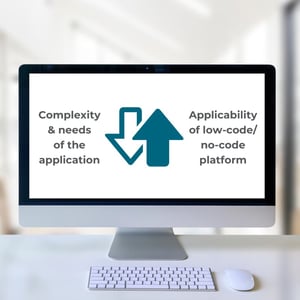Years ago, when I was leading technical teams at Nationwide Insurance, they launched the marketing slogan "Life comes at you fast." Some of the developers in the company quickly adopted the phrase for our own purposes. It rang true as we navigated the never-ending parade of new technology and new ways to design software.
It was, and still is, confusing to know what tools and methods to adopt. And we are the software people! If it’s confusing to us, it’s likely a dark art to the rest of the world. Some of the latest tools on the scene that we know people are still wrapping their heads around are low-code/no-code software development platforms. We thought it might be useful to share our thoughts on how they might benefit our readers.

If you take one thing away from this blog post, let it be this:
Deciding whether or not use low-code/no-code platforms for human services solutions is really deciding on the right tools for the experience you wish to create and accepting the constraints that come with your chosen platform.
To begin with, let's get specific about a couple of concepts:
- A software solution in the modern era is more than functionality. People use it willingly because it both solves their problems and provides an acceptable, if not enjoyable, experience.
- Software should help, not hinder the user. Northwoods’ Director of Product has engrained in our heads that any solution we create must be useful, usable, and desirable. Hit those three goals and you are likely to have success.

A Quick Primer on Low-Code/No-Code Platforms
A low-code/no-code platform, in the simplest sense, is an abstraction of (wrapper around) code, which means it literally wraps around existing lines of code on the backend of the application. It hides the cryptic business of authoring logic into something a machine can run and presents the human with something they understand—usually drag and drop blocks that can be assembled into patterns to make computers do work. It can be a very quick and enjoyable process, even for someone with limited development experience.
For the purposes of this post, I won’t get too far into definitions, but you can check out these resources if you want to dive deeper into the details of low-code/no-code platforms:
- What is Low-Code and No-Code? A Guide to Development Platforms (ZDNet)
- What is No-Code? (Unqork)
- Cracking Low-Code (KPMG)
- How Low-Code and No-Code Platforms Benefit Agencies (StateTech)
So now that we are all on the same page, how do we decide what is right for our respective organizations?

Key Considerations When Choosing Software Development Platforms
The important relationship to remember is that when it comes to creating software, convenience comes with constraints. When software functionality has been pre-packaged for convenience, as is the case with most low-code/no-code platforms, a whole slew of decisions has been made prior to your team making the first mouse click.
 For the decision maker, this means there is an inverse relationship between the complexity of how a solution should be designed and the applicability of low-code/no-code platforms to create it.
For the decision maker, this means there is an inverse relationship between the complexity of how a solution should be designed and the applicability of low-code/no-code platforms to create it.
The more simplistic the needs of the application, the more likely an acceptable solution can be produced with a low-code platform.
Basic applications that perform straight-forward CRUD (Create, Read, Update, Delete) operations are a great target for low-code/no-code platforms—for example, stand-alone web and mobile portals that have a few screens and only need to handle basic data entry and lightweight feedback to the user. (It is also worth noting that this type of less complex application is more common and appropriate than some software shops would like you to believe.)
If, however, you need to create a rich and seamless experience for users in a complex, mission-critical environment, a low-code/no-code platform usually brings with it too many constraints. Think minimal configuration, generic workflows, basic security and privacy features, etc.
At Northwoods, we choose to stay true to human-centered design. It would be difficult, if not impossible, to create our tools for frontline child welfare and economic assistance caseworkers from a low-code/no-code platform. It is a custom experience that needs to be woven together in a very specific way to be useful, usable, and desirable.
Some examples:
|
Local human services agencies need to manage state, county, and outside agency/provider forms that are built to match what’s required for their state system, while giving workers flexibility to interact with a form the way they need to based on their situation. This requires our forms design team to work with each customer to build out (and continuously maintain) exactly what they need. |
|
|
Our child welfare solution Traverse can read case files and surface key insights that enable caseworkers to mine content to understand children and families as well as they can. The automatic process uses a combination of machine learning and industry experts to develop a social services ontology that a low-code/no-code platform simply couldn’t replicate. |
|
|
Our applications also integrate with multiple back-end systems and data sources. Beyond the complexity of the solution experience, it is also important to consider integration. Will your application stand alone or need to integrate with external systems and data sources? The more complex the flow of data, the less ideal a low-code/no-code platform becomes. |

Finding the Right Tool for the Right Job
Ultimately, it pays to be honest with yourself about the work in front of you. If a significant part of your work falls into the less complex category, you may very well benefit from a low-code/no-code platform. And it will likely expand the pool of human talent you can leverage to help create your solutions. However, if you are tasked with something more complex, a low-code/no-code platform may not be the right tool for that job.
In fact, low-code/no-code platforms are just that—another tool. Of course, no one tool ever solves all of our software problems. But if you have the RIGHT tool for the job in front of you when you are creating, you are far more likely to deliver the right solution.
Don Abney, chief technology officer, oversees Northwoods’ product development, product management, and solution engineering teams. His vision and strategy for Northwoods’ product offerings stem from a core belief: technology problems are people problems, and if we’re empathetic toward the humans involved in creating and using software, we’re capable of achieving truly amazing things.

